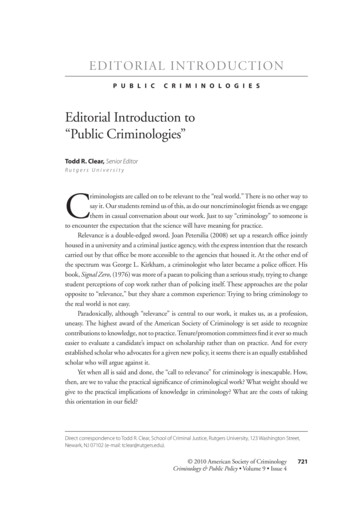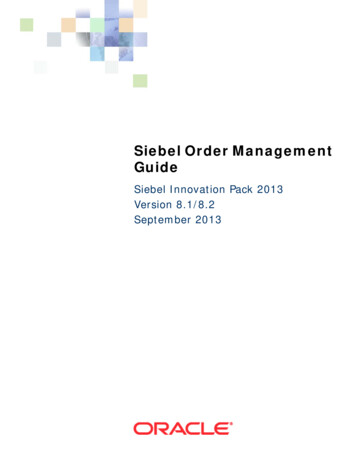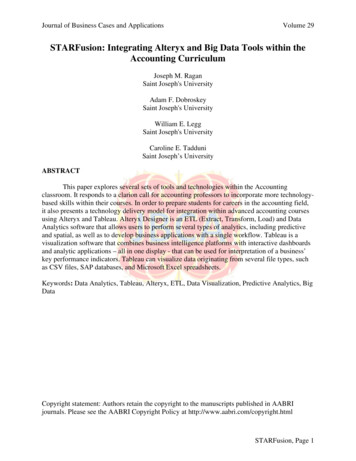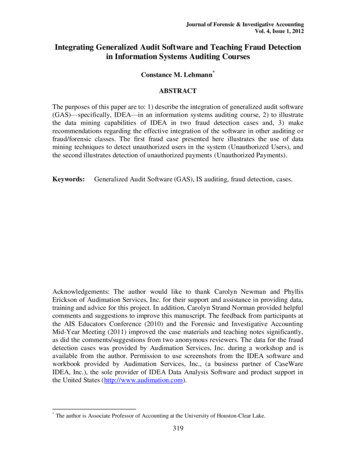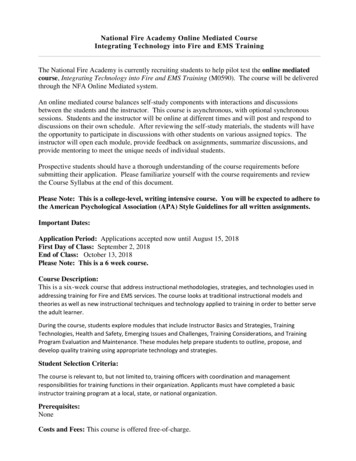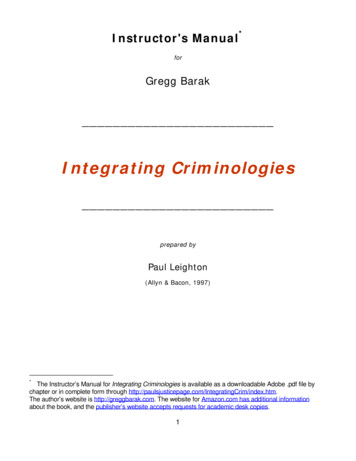
Transcription
*Instructor's ManualforGregg BarakIntegrating Criminologiesprepared byPaul Leighton(Allyn & Bacon, 1997)*The Instructor’s Manual for Integrating Criminologies is available as a downloadable Adobe .pdf file bychapter or in complete form through htm.The author’s website is http://greggbarak.com. The website for Amazon.com has additional informationabout the book, and the publisher’s website accepts requests for academic desk copies.1
PREFACECriminology is important and challenging work, but I have wondered for a while(relative to my age) whether it is really an academic 'discipline'. Rather, it seemedlike a 'problem area' that touched on a variety of issues dealing with human nature,society and politics. Also, while philosophy classes are much ridiculed for not beinghelpful in gaining employment, I always felt they were asking important questionsrelevant to all disciplines – that a thorough discussion of any discipline ultimately endsup in philosophical questions about knowledge and existence.Integrating Criminologies and its ‘post-postmodern’ perspective was thusexciting to receive and stimulating to read. Many others who see the wisdom inmultidisciplinary studies will feel the same way, as will some of those who are bored orin a rut because of what Barak calls ‘the sterile backwaters of disciplinary criminology’.Students, too, can benefit from reading larger issues about the production ofknowledge and its synthesis. Indeed, such a pedagogy is increasingly needed for allof us who live in an information processing society that is increasingly fragmentedand driven by sound-bites.Some of the content of Integrating Criminologies will be familiar to those whohave taught criminology classes before. There is, however, a broader range of topics-- from genetics to new world cybernetics -- and a stronger emphasis onepistemology. The idea is to integrate and synthesize these diverse bodies ofknowledge that all relate to criminology. Integration is done not simply withindisciplines, but across them. The modernist knowledge discussed in most criminologytexts is related to postmodern critiques that denaturalize the 'knowledge' produced by'criminologists'. The result is an effort to create a criminology for the 21st centurythat yields a more complete understanding of crime and better policies for dealingwith it. As the text notes in several places, however, academic disciplines and fieldslike criminology exercise disciplinary functions regarding the extent, organization andcontent of its knowledge. Barak poses a challenge to criminology to think morebroadly, more deeply and more self-reflectively. Because it does disturb the routinesof ‘normal science’, the text is bound to encounter obstacles to its acceptance, and myhope is that this instructor’s manual can facilitate acceptance in some small way.At this time, the text is in production so the ideas in here are not field tested inthe classroom. Nevertheless, this manual does offer assistance by summarizingeach chapter, providing an outline and learning objectives. There are alsoideas for discussing each chapter in class, or at least stimulating further thinkingon how to approach this material in class. In my commentary, I have tried to mentionmaterials that are short but interesting reads. Such materials are tagged with anasterisk after the reference; dates in brackets are not references, but indicatehistorical periods.Instructor’s Manual for Integrating Criminologies page 2 of 63. Additional information is availablethrough http://paulsjusticepage.com. Recommended: http://crimetheory.com.
ng,postmodernism I would suggest Fillingham’s (1993) book. This ‘for beginners’ bookis a strong overview that contains many illustrations and can be read in an afternoon.Among the thousands of other books on the topic, I would recommend Poster’sCritical theory and Poststructuralism (1989), which is informative and readablewithout being too dense. Lastly, Sheridan has translated much of Foucault fromFrench, so he has some excellent insight. Unfortunately, at times he writes very muchlike Foucault and thus does not always demystify, but his work (1980) can be helpfulin making sense of the philosopher’s work about knowledge, subjects and domination.Good luck & best wishes.P.S.L.Olympia, WASpring 1997A note of thanks: My recent status as a migrant academic has made productivity(including work on this manual) difficult. I will not list the difficulties, but wish to saythanks in particular to Bonnie Berry and Pete Lara. My parents have also been quitesupportive through school and the transitions afterward; they have my love andgratitude.Instructor’s Manual for Integrating Criminologies page 3 of 63. Additional information is availablethrough http://paulsjusticepage.com. Recommended: http://crimetheory.com.
CONTENTSCHAPTER 1Crime and Criminology: An Integrative PerspectiveCHAPTER 2Crimes and Harms: A Comparative PerspectiveCHAPTER 3Punishment and Criminology: An Historical PerspectiveCHAPTER 4Theory and Practice: On the Development of Criminological InquiryCHAPTER 5Contributions from Biology: 'Body and Temperament'CHAPTER 6Contributions from Psychology: 'Mind and Nature'CHAPTER 7Contributions from Sociology: 'Environment and Structure'CHAPTER 8Contributions from Law and Economics: 'Reason and Rationality'CHAPTER 9Integrating Criminological Theories: A CritiqueCHAPTER 10Integrating Criminological Knowledges: A 'Post' Postmodern SynthesisCHAPTER 11Integrating Culture, Media, and Gender Studies: An Interdisciplinary Perspective onCrime ProductionCHAPTER 12Integrating Crime and Social Control: An Interdisciplinary Approach to CrimeReductionREFERENCESInstructor’s Manual for Integrating Criminologies page 4 of 63. Additional information is availablethrough http://paulsjusticepage.com. Recommended: http://crimetheory.com.
CHAPTER 1Crime and Criminology: An Integrative PerspectiveOVERVIEWAs computers have sped up the flow of 'information', people increasingly attendto 'factoids', news 'McNuggets' and decontextualized bits/bytes. In higher education,people adapt to the frenetic growth of information by becoming ever more specialized,as reflected in the joke that they know more and more about less and less until theyknow everything about nothing. The less charitable version likens the process to abird flying in ever tighter circles until it disappears up its own anus. Textbooks(written by specialists) tend to become catalogs of more detailed pictures of variousspecies flying in different arcs at various speeds.This chapter critiques the fragmented state of knowledge and the disciplinaryforces exercised by the academic disciplines engaged in criminology. Barak advocatesmergers, not just of theories within a discipline, but of bodies of knowledge in alldisciplines concerned with the study of society and human nature. In this way, we canstart to avoid sterile backwaters of disciplinary criminology and appreciate thecomplexity of the human condition. Only by including nature and nurture can wecreate comprehensive understandings.Only by including modern/positive andpostmodern/deconstructive perspectives can we get a full sense of what criminology isabout -- not just 'why do criminals do it?', but the relation of criminology to political,economic and cultural development in a world being changed by global capitalism andmass-communications.OUTLINEI In search of CriminologyA. Survey of terms by Radzinowicz [1962] and Barak [1994]B. Criminologists prefer to concentrate on few 'strands' rather than pursuebreadthC. Need for interdisciplinary or transdisciplinary criminology thatincorporates the 'social facts of crime' with the 'why docriminals do it?'1. Need to reverse fragmentation that occurs in postmodernism2. Need to re-order criminology away from penal-administrativeforms toward more social-democratic onesD. Integrate knowledges by confronting the social-structural interaction ofminds, cultures and bodiesInstructor’s Manual for Integrating Criminologies page 5 of 63. Additional information is availablethrough http://paulsjusticepage.com. Recommended: http://crimetheory.com.
II What is Criminology?A. Three positions on the nature of the field1. Sociological traditionalists: criminology as subdiscipline of sociology2. Multidisciplinary specialists: elevate own (non-sociological)discipline's importance for study of criminology3. Interdisciplinary generalists: knowledges from broader range of fieldsB. Need for interdisciplinary mergers of knowledge between 'equals' with noprivileged ranking of knowledges.III The Need for IntegrationA. Stems from:1. Wide dissemination of criminological knowledge, esp. through massmedia2. Production by non-experts3. Disciplinary academic structures (including departments) have owneconomies of value; they artificially shape knowledge through theirdiscourses (including textbooks) and reproduce themselves4. Lack of awareness that criminology is the result of power and cannotbe separated from the dominant values of a societyB. Why Integrate?1. Helps expose narrowness and sterility of knowledge produced bysingle disciplines2. Emphasizes complex nature of reality and people as both determinedand determining3. Expands utilitarian knowledge base of social control4. Criminological Inquirya. Importance of paradigms and disciplinary structures thatinfluence where investigators look for facts, the observationalinstruments they select, and the interpretations they makeb. Everyone operates from some paradigm, so there is no neutralparadigm- (value-)free criminologyc. Integrate for comprehensiveness, but argue about (single)'correct' paradigm4. Criminological Pedagogya. Students interested in criminal behavior and familiar with itb. Use enthusiasm to create opportunity for critical thinking andexamination of implicit assumptionsC. What Should Criminology integrate?1. Goalsa. Conventional: etiology, prediction, falsification of theories,crime controlb. Critical: understanding, peace, emancipation, amelioration ofsufferingInstructor’s Manual for Integrating Criminologies page 6 of 63. Additional information is availablethrough http://paulsjusticepage.com. Recommended: http://crimetheory.com.
c. Be open to new goal of integrating both, which unsettlesexisting assumptions about crime and research processes2. Types of integrationa. Modern integration of theories: positivistic emphasis on theoryand 'causal models'b. Postmodern integration of knowledges: emphasis on everchanging voices of plurality that provide meaning for the localsites of crime, justice, law and community; relational,positional and provisional interpretation3. Ingredientsa. Human agencyb. Socialization and identity formationc. Social structure and institutional orderd. Discourse, knowledge and mass communicatione. Social and cultural changeD. How Should Criminology Proceed?1. Interdisciplinary studies questions about crime and culture, gender,ethnicity, media, and policy2. Recognizea. Modernist contribution of measurement and observation oftangible things -- what the reality isb. Postmodern contribution of appreciating imagination and thesubjective -- the perceptual and conceptual systems of humanminds that shape how reality is understoodIV Definitions of CrimeA. Reveal that definitions are somewhat arbitrary, non-objective, changing, andrelated to political, economic, social, and ideological structuresB. They include1. A form of normal behavior2. A violation of behavioral norms3. A form of deviant behavior4. Legally defined behavior5. A universally condemned behavior6. A violation of human rights7. A social harm8. A social injury9. A form of inequality10. A limit on one's ability to make a differenceLEARNING OBJECTIVES1] Introduce students to the wide range of issues, questions and theories that fallInstructor’s Manual for Integrating Criminologies page 7 of 63. Additional information is availablethrough http://paulsjusticepage.com. Recommended: http://crimetheory.com.
under the domain of criminology. Professors and students should start to becomemore aware of their own disciplinary perspectives and prejudices.2] Emphasize the constructed nature of both reality and knowledge; academicdisciplines arbitrarily divide up this knowledge, and exert a continuing disciplinarypower that shapes knowledge and keeps it fragmented.IDEAS FOR LECTURES & DISCUSSIONThe instructor should think about her/his own disciplinary biases and start the classthinking about theirs. Ask them what seems to be the most important questions andwhy. This discussion could help illustrate the breadth of criminological inquiry and/orthe extent to which they may be sociological traditionalists.For more information on disciplining effects of disciplines, see Ball 1990. The titlemakes this volume seem a little more relevant than it might actually be for helpingprepare lecture material, but the introduction in particular provides a concise overviewof Foucault. Fillingham (1993)* is also a good overview of Foucault’s work. While hisbook The Order of Things is not generally recommended reading (especially as anintroduction), the classification system Foucault starts with would be good to facilitatea discussion of how even arbitrary classification systems shape the way people thinkand the problems they study. (The example divides up the animal kingdom, includingcategories of imaginary animals and those belonging to the emperor, etc.)Berry's (1994)* discussion of 'artificiality' in the production of criminologicalknowledge is an excellent read on how disciplinary forces -- including funding sourcesand journal review -- produce irrelevant or biased 'knowledge'.Barak suggests that the instability of 'crime' – the politics of harms that do or do notbecome criminalized -- naturally leads students to asking questions that crossdisciplines. Use this strategy and any enthusiasm the students bring to class to set upthe discussion of definitions and measurement in Chapter 2. Find out their reactionsto the series of vignettes at the end of the chapter and their thoughts about the rangeof definitions he presents. Finding out which definitions they like or do not agree withwill help get a fix on the perspective of the class.Instructor’s Manual for Integrating Criminologies page 8 of 63. Additional information is availablethrough http://paulsjusticepage.com. Recommended: http://crimetheory.com.
CHAPTER 2Crimes and Harms: A Comparative PerspectiveOVERVIEWThis chapter provides a conceptual comparison of what constitutes crime thatproblematizes its definition and measurement. Barak outlines the sources ofinformation about crime -- UCR, NCVS, self-reports and archival research -- and whatthey tell us about patterns and demographic patterns (victimization by age, gender,race, etc.). While discussion of the limits and 'dark figure' of crime is part of positivistscience, he extends this discussion into a critical and postmodern integrative critique.While noting that the dark figure includes unreported and undetected crimes, he alsoasks about other harms that are not included. The history of crime trends looksdifferent when capitalist genocide of indigenous people is counted in with homiciderates.Ultimately, both the definitions and measurements of crime are shown to berelated to power. Acts that can be categorized as crimes of domination and control -genocide, corporate and government crimes -- are less likely to be defined as crime,counted in victimization tallies, or be the subject of any counting at all. Crimes ofresistance by those with the least power are what criminology is 'about', while the'crimes of the public' are most likely to attract punishment when they threaten theaccumulation of the more powerful.OUTLINEI IntroductionA. Reasons for inaccuracy of crime statistics1. Disagreements on what constitutes crimea. Something that should be counted and is notb. Something should not be counted and is2. Undetected crimes, or 'the dark figure'3. Crimes detected but not reported4. Crimes reported to police but not recordedB. Crime statistics may tell us more about practices of criminal justice systemthan the 'true rates'; we can never know what the true rate is or how it ischangingII Official and Unofficial CrimeA. FBI's Uniform Crime Reports1. Voluntary national program involving 16,000 law enforcement9
agenciesa. Information about persons arrestedb. Information about offenses known to police1) Part 1 offenses: murder and non-negligent manslaughter,forcible rape, aggravated assault, robbery, burglary, motorvehicle theft, larceny theft and arson2) Part II offenses: 21 other less serious crimes and statusoffenses2. Excluded from (Part 1) 'Index' crimesa. Part II offensesb. Harms not recognized as crimesc. Undetected crimesd. Unreported crimee. Crimes of control (genocide, price fixing)f. Crimes of the public (cheating on income tax or insurance)B. National Crime Victimization Survey1. Census Bureau interviews sample of households2. Shows 40 - 50% more crime than UCRC. Self-Reports1. Asks groups (esp. youth) about own law-breaking2. Finds high volume of trivial crimes (rather than serious, dramatictype found in media)D. Archival Research1. Produced by historians and anthropologists and historians (etc.),often overlooked as a source2. Reveals information about changing nature and production of crimeE. Contradictions1. UCR showed crime on the increase until the early 1990s, while NCVSshowed a declineIII Homicide and GenocideA. Definitions1. Homicide: killing that may be criminal depending on circumstances2. Genocide: deliberate mass murder (term not found in law dictionary orcriminology textbooks)3. Genocides are homicides, so all historical discussions about crimeand violence require caveatB. Homicide in the U.S.1. Rate of 9/100,000 in cross cultural context2. This century, rate has varied between 5 and 10/100,0003. Rates of black homicide highera. 6 to 7 times the white rate during the last 50 yearsb. Rate for black males 15 to 19 is 11 times the white rateC. General history of homicide trendsInstructor’s Manual for Integrating Criminologies page 10 of 63. Additional information is availablethrough http://paulsjusticepage.com. Recommended: http://crimetheory.com.
1. Rates high in Middle Ages (before city and crowding)2. 19th century US rates higher than 20th century rates3. Downward trend explained bya. 'Civilizing process'b. Increase in coercive power of the state, concentration ofmercantile property and formation of private militia4. Downward trend ignores millions of indigenous victims of capitalistgenocide (1500-1750)a. Slave tradeb. Spanish killed 95-99% of natives in some South Americancities; 60 - 80 million deaths by 17th Centuryc. Deaths from capitalist crimes of control subsided because ofneed for cheap laborIV Criminal Victimization in the US (1970-2005)A. In 1992, 6.6 million violent victimizations (NCVS)1. 5% of households experienced violence2. Lowest since 1975, but not decreasing for all groupsB. Youth1. Since late 1980s, disproportionate number of killers and victims2. Increasing violence at a time of smaller 15-19 year old cohortC. Persons and Property1. Violent crime stable2. Theft downD. Gender1. Women more likely to be killed by family or intimate2. Women more likely to kill family or intimateE. Children1. 3 million cases of abuse and neglect2. 1,300 deaths, mostly children under 4F. Crimes against women1. 2.5 million women experience violence annually2. One-third of victims injured3. Half reported to police4. Murder and rape most likely in small and medium-sized towns5. Does not count sexual harassment, discrimination and molestation6. Sexual crimes worse in places like the Middle East and South Asiaa. Molesting of women on crowded bussesb. Reluctance of women to report crimes because of taboos andfurther victimizations from criminal justice officialsG. Victimization in the workplace1. One million violent victimizations, 160,000 injuries2. Two million personal theftsInstructor’s Manual for Integrating Criminologies page 11 of 63. Additional information is availablethrough http://paulsjusticepage.com. Recommended: http://crimetheory.com.
V White Collar CrimeA. Few statistics available, but seems to be growing and acceptableB. Types of offenders1. Individuals who act against individuals2. Insiders who act against their organization3. External criminalsC. Classification (federal system)1. Counterfeiting2. Embezzlement3. Forgery4. Fraud5. Regulatory offensesD. Statistics1. Severely undercounted (tax fraud and pilfering from work doneby millions)2. In 1985, 28,000 crimes; 10,733 persons convicted, mostly for fraud3. Slightly higher conviction rate for WCC offenders, but smallerpercentage sentenced to incarceration and for shorter sentences4. WCC defendants more likely to include women, nonwhites and collegeeducatedE. Counterfeit goods1. 'Knockoff' designer clothing, bootleg music and video, and copyrightviolations2. Part of 'hidden economy' that's accepted because 'everyone does it'F. Computer crime1. Wide range of harms constitutes fastest-growing type of wrongdoing2. Law and police force has not caught up with technology3. Problem of computer viruses, illegal copying of computer programs,time theft, unauthorized erasure of data, unauthorized access(hacking), espionage, fraud and vandalismVI Corporate and State CrimeA. Crimes of control or domination: committed by powerful groups on behalfof the accumulation of capital1. Victims are consumers, workers, public and environment2. Account for largest portion of losses, but no sources of information3. Culture of denialB. Corporate crime1. Injurious acts undertaken to facilitate capital accumulationa. Reduce production costs (violate safety requirements, breakunions)b. Increase price or volume (monopoly, false advertising, pricefixing, bribes)2. Examples include: Dalkon Shield, Pinto gas tank, E.F. Hutton's checkInstructor’s Manual for Integrating Criminologies page 12 of 63. Additional information is availablethrough http://paulsjusticepage.com. Recommended: http://crimetheory.com.
kiting scheme, Exxon Valdez spill, Savings and Loan fraud and BCCIC. State crime1. Acts or omissions for personal gain or to support the prevailing politicaland economic arrangementsa. Acts include surveillance, harassment, imprisonment, drug andarms tradingb. Omissions include policies that result in victimization throughthe denial of basic needs (food, clothing and shelter)c. Robs citizens of effective representation, underminesdemocratic processes and equal protection of the laws2. Examples include: Watergate, Iran/Contragate, IraqgateVII SummaryA. Crime can be found anywhere in the USB. Not good or bad people, but related to organization of political, economicand social resourcesC. Problems with data make it hard to say if crime is increasing ordecreasing; even less can be concluded about corporate and state crimeLEARNING OBJECTIVES1] Acquaint students with the tools criminologists use to study crime and review thepicture these methods suggest.2] Have students appreciate the (methodological and definitional) flaws thatcontribute to the dark or hidden figure of crime.3] Introduce idea that a discussion of ‘crime trends’ is based on a specific, but notobjective, definition that excludes genocide and crimes of control; definition andmeasurement (and thus discourse and the ‘reality’ about crime) are related topower(/knowledge).IDEAS FOR LECTURES & DISCUSSIONMany students who study criminology know what the UCR or NCVS is, but have neverused these reports. One useful exercise is a worksheet that requires them to gothrough these volumes to find certain statistics. The result is relatively easy to gradeand the questions can be keyed to larger issues in the lecture (race, gender, reasonsfor not reporting to police, etc.). Worksheets or class lessons can also contrast thegreat detail of data available on street crime with white collar crime in general andcrimes of domination in particular. Indeed, no single government agency collects dataon the cost and extent either of white collar or corporate crime. (Ask the class to findand review an article on the aggregate costs of corporate crime.) The 1993 redesignInstructor’s Manual for Integrating Criminologies page 13 of 63. Additional information is availablethrough http://paulsjusticepage.com. Recommended: http://crimetheory.com.
of the NCVS – different screening questions and the expanded use of computerbased interviewing – greatly expanded the volume of crime reported. This disjuncturecould be used to help make the point that the result depends on how hard we lookand our methodology as much as what’s happening ‘out there’.There is a relationship between power, knowledge and labeling: Harms by the mostpowerful against the less powerful are least likely to be defined as crimes or countedin any way. Although there is some information about 'white collar crime', it tends tobe from insurance companies or other industries reporting how they are ripped off byindividuals (many of whom are middle or upper class). Less information is availableabout the industry’s behavior, be it price fixing, fraud, problems with less thanuniversal heath coverage, etc. The chart in Chapter 3 of Reiman (1997) starts to tallyup the financial cost of all such crimes, but underrepresents the cost of harms done bythe most powerful.For some more thoughts on genocide that raise the issue of African Americans in theUnited States, see Anderson (1995); Johnson and Leighton (1997)*.Michael Moore (the creator of the movie Roger & Me) opens his book with a picture ofthe bombed out Federal Building in Oklahoma City and factory in Flint, Michigan, thatGM demolished after closing. He asks, What is terrorism? Although GM movedeveryone out of the building first, the company's plan to close plants destroyed thelives of thousands of lives: some will kill themselves, others (mostly women) will die indomestic disputes over, say, the lack of money. Others will "be killed more slowlythrough drugs and alcohol, the substances of choice when one needs to ease the painof his or her life being upside down and shoved into an empty, dark hole" (1996:15).Many students (and others) see this action as acceptable and justify it in terms ofprofit. A later section of his book explores this reasoning: "If profit is supreme, whydoesn't a company like General Motors sell crack?" (1996:254). Well, it is illegalbecause we as a society have determined that it destroys people's lives andcommunities. "If we wouldn't let GM sell crack because it destroys our communities,then why do we let them close factories? That, too, destroys our communities"(1996:255).There are many acts -- from distributing child pornography tomanufacturing chemical weapons for the free market -- that we don't allow, so why dowe allow downsizing (in a time of record profits)?Moore writes in a direct and humorous way that can be good for classroom use. Manystudents will know his movie Roger & Me, which could also be used in class. Histelevision series, TV Nation, introduced a corporate crime fighting chicken (as acounterpoint to the McGruff dog 'take a bite out of crime' campaign). Many of theseepisodes [and/or his corporate crooks trading cards (1996: 108)] would be engagingways to raise the topic of crime in the suites and crime in the suites.Reiman's discussion in Chapter 2 of Chapter 2 of The Rich Get Richer and the Poor GetPrison (1997) is also a good overview of how the social reality of crime is created, andInstructor’s Manual for Integrating Criminologies page 14 of 63. Additional information is availablethrough http://paulsjusticepage.com. Recommended: http://crimetheory.com.
he answers some objections from 'Defenders of the Present Legal Order' aboutintentionality, directness, etc in corporate and street crimes. He also has a chart thatcompares how the FBI says Americans are killed with one that includes occupationalhazards, inadequate health care, etc.Johnson, Robert and Paul Leighton. 1997. "American Genocide?: The Case of theBlack Underclass" in Craig Summers and Erik Markusen (eds) Collective Violence:Harmful Behavior in Groups and the Government. Totowa: Roman & Littlefield, ackgenocide.htm.Reiman, Jeff. 1997. The Rich Get Richer and the Poor Get Prison, 5th ed. Boston:Allyn & Bacon. The companion website for Reiman’s book is available ructor’s Manual for Integrating Criminologies page 15 of 63. Additional information is availablethrough http://paulsjusticepage.com. Recommended: http://crimetheory.com.
CHAPTER 3Punishment and Criminology: An Historical PerspectiveOVERVIEWThis chapter examines the tenuous relationship of punishment to prevailingtheories of criminology and its connection instead to social structure (productiverelations) and culture. Punishment refers to criminal sanctions, but also includesgendered mechanisms of power such as surveillance and discipline that are used torecreate the privileges and inequality of the social order.Barak reviews the main moral justifications for punishment, which he dividesinto backward looking ones (revenge and retribution) tied to the character of theoffense and forward looking ones (deterrence, incapacitation and rehabilitation) tied toutilitarian consequences. The work of Durkheim, Rusche and Kirchheimer, andFoucault is reviewed to show the relationship of punishment to ideology/solidarity,systems of production, larger issues of 'political technologies of the body' (power,knowledge, and the body).The nature of the contemporary state of American punishment ('corrections') isreviewed and found to be large, expensive and rapidly growing. The curren
disciplines concerned with the study of society and human nature. In this way, we can start to avoid sterile backwaters of disciplinary criminology and appreciate the complexity of the human condition. Only by including nature and nurture can we create comprehensive understandings. Only by including modern/positive and
